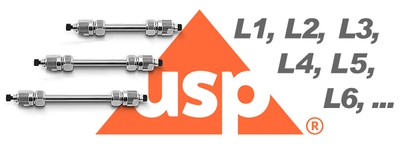Technical Data
Change in the stationary phase
Changes to the stationary phase are generally permitted. However, the L category of the USP must be retained and must not be changed.
Changing the column dimension
Changing the column dimension (length, inner diameter and particle size) is possible within certain limits. The limits for changing the dimensions vary depending on the method (isocratic or gradient) and based on whether a completely porous material (Totally Porous Particle, TPP or Fully Porous Particle, FPP) is to be replaced by a core-shell particle (SPP). The conditions only relate to the length and particle size. The inner diameter can be freely selected.
TPP to TPP with Isocratic and gradient methods
The length (L) and the particle size (dp) are required to calculate the criteria.
L/dp: from -25% to +50%
Firstly, this quotient should be calculated for the column recommended in the USP. This result is the starting point for the range -25% to +50%. For a column with a different dimension, L/dp should lie within the determined range.
TPP to SPP for Isocratic methods
When changing from fully porous to core-shell materials, a different criterion is used for the change in dimension. Here the base number N is the most important factor.
N: -25% to +50%
The base number of the original USP methods is determined and compared with the base number of the core-shell column. The ratio of L/dp does not have to be in the range of -25% to +50%.
TPP to SPP for gradient methods
Gradient methods do not allow a simple determination of the soil number and therefore another criterion is used. The retention time tR is setin relation to the width at half heightWh.
(tR/Wh)2: -25% to +50%
In this case, this ratio is again compared with the original USP method. As with isocratic methods, the ratio of L/dp does not have to be in the range of -25% to +50%.
Adjustment of the flow rate
If the dimensions of the column have been changed, this will result in adjustments to the flow velocity (flow rate). The flow rate for the new column dimensions can be calculated based on the original values. The following formula is used to calculate the new flow rate:
In addition to this formula, the flow can be adjusted by ±50% for isocratic methods without the need for revalidation.
Adjustment of the gradient time
In the case of a gradient, in addition to the flow rate, the gradient time tG must also be adjusted for each segment of the gradient. Both the length L and the internal diameter dc as well as the determined flow rate F2 play a role here. The gradient time can be calculated using the following formula:
Changing the injection volume
A change in the column dimensions (length L and internal diameter dc) inevitably results in a change in the injection volume. It does not matter whether it is an isocratic or gradient method. The adjusted injection volume can be calculated using the following formula:
Change in the composition of the mobile phase
Isocratic method
The component with lower proportions (≤50%) may be adjusted relatively by ±30% but may not exceed ±10% in absolute terms.
Example: In a 50/50 mixture, 30% of 50 would be a change of 15%. This would not be permitted and therefore the composition may change by a maximum of 10%, i.e. in the range of 60/40 to 40/60.
Gradient method
For gradients, the main peak should elute within ±15% of the retention time. However, this does not apply if the dimensions of the column have been changed. If the dimensions of the column have been changed, the mobile phase should be selected so that the first peak is sufficiently retarded and the last peak is eluted.
Change of further parameters
Column temperature
The temperature may be adjusted by ±10°C for isocratic methods. For gradient methods, the temperature may be varied by ±5°C.
pH of the mobile phase
The pH value of the mobile phase may be varied by ±0.2 units for both isocratic and gradient methods.
Salt concentration
The salt concentration in the mobile phase may vary by a maximum of ±10%, but the pH deviation limit must be observed.
Wavelength of the detector
The wavelength of the detector must not be changed.

![[English:] [English:]](https://cms.mz-at.de/fileadmin/_processed_/f/e/csm_image_categories-hplc-columns_marken_web23_w600-h225px_667afc1db7.webp)

![[English:] [English:]](https://cms.mz-at.de/fileadmin/_processed_/a/f/csm_image_categories-hplc-columns_hersteller_web23_w600-h225px_81b652d0bf.webp)
 MZ-AT USP by HPLC Columns Listing 2020
MZ-AT USP by HPLC Columns Listing 2020